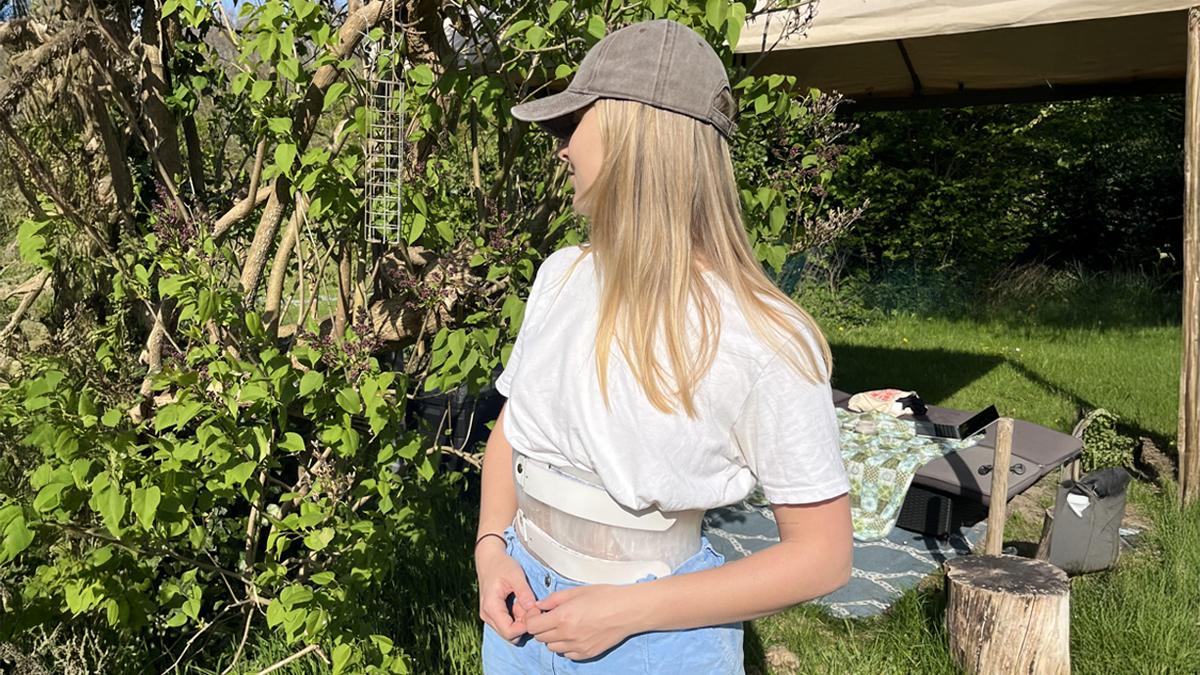3D-printed brace helps Astrid keep an active life
“I’m a special case,” Astrid says with a big smile. That’s how our interview begins—our first impression of an active young woman with a lot of drive. And we’re about to learn how she’s using that drive to pursue a full and active life, despite living with scoliosis.
This interview is part of a spotlight on Astrid’s experience as one of the first three people in Denmark to use a 3D-printed spinal brace. The specialists at Dansk Skoliosecenter developed her treatment plan in collaboration with orthopedic engineer Thomas Borregaard. But let’s start from the beginning.
“You can get surgery or learn to live with it”
“I was 13 years old when I found out I had scoliosis,” Astrid recalls, “but the doctors said it was too late to start treatment with a spinal brace.” She was given two options: undergo surgery or learn to live with the condition.
At the time, she wasn’t experiencing much discomfort and was afraid of the surgery—something that still holds true today. “For me, surgery is the last resort, only to avoid early retirement. I’ll do anything to avoid it. It’s so invasive, carries a high risk of long-term complications, and would put an end to my active lifestyle.”
Surgery was the only option presented at the time, and she and her parents decided against it. Her only point of contact in the healthcare system was the surgical team, and when she declined the operation, she was left to figure things out on her own.
Staying active is part of her treatment
Astrid learned to take care of her body through movement and strength. Living with scoliosis means managing tight muscles from uneven strain, so regular physiotherapy and sports massage are part of her routine. In a typical week, she swims, runs, and practices Pilates. In less typical weeks, you might find her skiing in Norway or the Alps.
Still, she’s realistic. Studying medicine, she’s aware that her condition could make it difficult to work long hours standing as a surgeon. “That’s why I made an appointment with ScolioFYS. I wanted to hear what the specialists would suggest.”
A surprising new option
Now 24, Astrid has spent 11 years shaping her life around scoliosis. So, when the team at Dansk Skoliosecenter suggested starting brace treatment after all this time, she was surprised. Recent experience shows that postural balance and spinal rotation can be treated even after puberty, and adults can benefit from bracing, too.
The team recommended intensive brace use for at least a year, possibly longer, followed by a maintenance phase.
The news was overwhelming. On one hand, relief—after all these years, there was finally a non-surgical treatment option. On the other hand, fear: wearing a brace +16 hours a day would be a big adjustment.
“But it wasn’t a hard decision,” Astrid says. “The relief of having an option that doesn’t involve surgery was the best news I could get.”
A modern brace, custom-fitted
That’s when she met Thomas Borregaard, a certified prosthetist-orthotist (CPO) and one of Denmark’s leading scoliosis experts. “Thomas took the measurements and recommended I try a 3D-printed correction brace,” Astrid explains. “I’d never worn a brace before, but he told me this version was lighter, more flexible, and easier to hide—without compromising the effect.”
When she began treatment in November 2024, Astrid had a 39-degree sideways spinal curve and a degree of 8 in vertebral rotation. After just five months, her results showed a 23-degree curve and only a degree of 4 in rotation without the brace on. That’s a remarkable permanent correction.
“We’ve seen that postural balance can be improved and spinal rotation reduced after puberty. Even adults can benefit from bracing,” says Thomas Borregaard. “In Astrid’s case, we recommended intensive brace wear for at least a year, possibly longer, followed by a maintenance phase.”
- Thomas Borregaard
What makes scoliosis bracing successful?
There are several factors that determine whether bracing will work, especially for young adults. First, the spine must have enough flexibility to allow correction. Second, the brace must be custom-made and precisely fitted to guide the spine’s alignment. Third—and perhaps most importantly—the brace must be worn consistently. In Astrid’s case, that means +16 hours every day.
One well-known challenge in scoliosis treatment is brace comfort, as described by experts like Matthew Dorsi. Uncomfortable braces are a common reason for poor outcomes because they are not worn enough. That’s where 3D printing brings a big advantage. These 3D-printed spinal braces are lighter, more breathable, and easier to wear discreetly under clothes, without limiting daily life.
That was one of Astrid’s concerns, too. But once she received the brace, all her worries fell away. It was light, discreet, and even looked good—people have even asked her if it’s a fashion item.
“It’s better than expected”
Wearing a brace isn’t always easy. “Sometimes it’s annoying,” Astrid admits. “It pushes a lot when I sit down, and sometimes I feel claustrophobic and painful.” Getting used to sleeping with it took effort, and she doesn’t wear it during training, mostly because it can’t be cleaned.
But overall, it’s better than expected. And it’s working.
Looking ahead
Astrid is still in the active phase of treatment, and the results look promising. For her, success depends on daily effort, physical training, and the motivation to avoid surgery. When this phase ends, she may need to wear a brace permanently to stabilize her spine.
But when the alternative is surgery, that’s a compromise she’s more than willing to accept.



